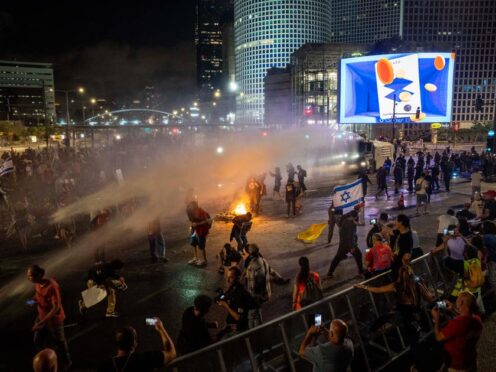Scuffles between Israeli police and protesters erupted in Tel Aviv after thousands gathered to demonstrate against the government and demand it brings back the hostages being held by Hamas in Gaza.
Some protesters carried photos of the female soldiers who appeared in a video earlier in the week showing them soon after they were abducted during the Hamas attack on Israel on October 7 which started the war between Israel and Hamas.
Others held banners reading “Stop the war” and “Help”. They called on the government to reach a deal to release the dozens of hostages still in captivity.
The protesters also called for the resignation of Israeli Prime Minister Benjamin Netanyahu and demanded an election.
“We all saw the video, we could not stay at home after the government abandoned all these people,” said Hilit Sagi, from the campaign group Women Protest for the Return of All Hostages.

Divisions among Israelis have deepened over how Mr Netanyahu has handled the war against Hamas after the attack that killed about 1,200 people and saw 250 others taken hostage. Israel says around 100 hostages are still being held in Gaza, along with the bodies of around 30 more.
Snir Dahan, the uncle of hostage Carmel Gat who remains in captivity in Gaza, said: “They are not doing enough in order for the hostages to come back, either with military force, with (a) hostages deal, negotiating. Nothing is being done.”
Earlier in the week, the bodies of three hostages were recovered from Gaza, Israel’s army said on Friday. The army said they were killed on the day of the attack and their bodies were taken to Gaza.
The announcement came less than a week after the army said it had found the bodies of three other Israeli hostages killed on October 7.
Around half of the 250 hostages taken by Hamas and other militants have been freed, most in swaps for Palestinian prisoners held by Israel during a brief ceasefire in November.

Mr Netanyahu’s government has faced increasing pressure, both at home and abroad, to stop the war and allow humanitarian aid into the enclave that is home to 2.3 million Palestinians, almost 80% of whom have been displaced.
Also this week, three European countries announced they would recognise a Palestinian state, and the chief prosecutor for the International Criminal Court requested arrest warrants for Israeli leaders, along with Hamas officials.
On Friday, the International Court of Justice ordered Israel to end its military offensive in the southern Gaza city of Rafah and to open the nearby border crossing for crucial humanitarian aid. The top United Nations court also said Israel must give war crimes investigators access to Gaza.
However, the judges stopped short of ordering a full ceasefire across the entire Palestinian territory, and Israel is unlikely to comply with the court’s ruling.
Israel says it makes every effort to avoid harming civilians and blames their deaths on Hamas because the militants operate in dense, residential areas.
In the past two weeks, more than a million Palestinians have fled Rafah as Israeli forces pressed deeper into the city.
Israel’s takeover this month of the Rafah border crossing, a key transit point for fuel and supplies for Gaza, has contributed to bringing aid operations to near collapse, the UN and relief groups say.

Israel says it needs to invade Rafah to destroy Hamas’s last stronghold.
Egypt has agreed to send UN humanitarian aid trucks through the Kerem Shalom border crossing, Israel’s main entry point into southern Gaza, but it remains unclear if the trucks will be able to enter because fighting still rages in Rafah.
Israel said aid is moving into the Palestinian territory through northern Gaza and though a US-built pier.
On Saturday, a small US military boat and what appeared to be a strip of docking area washed up on a beach near the southern Israeli city of Ashdod.
The US Central Command said four of its vessels supporting the humanitarian aid mission were affected by rough seas, with two of them anchoring near the pier off the Gaza coast and another two in Israel.
US officials said no injuries were reported and they are working with the Israeli army to recover the vessels.
Meanwhile, Israeli bombardments are continuing in Gaza, and the health ministry said on Sunday the bodies of 81 people killed by Israeli strikes have been brought to local hospitals over the past 24 hours.
That brings the overall Palestinian death toll from the war to at least 35,984, said the ministry, which does not distinguish between civilians and fighters in its count.
